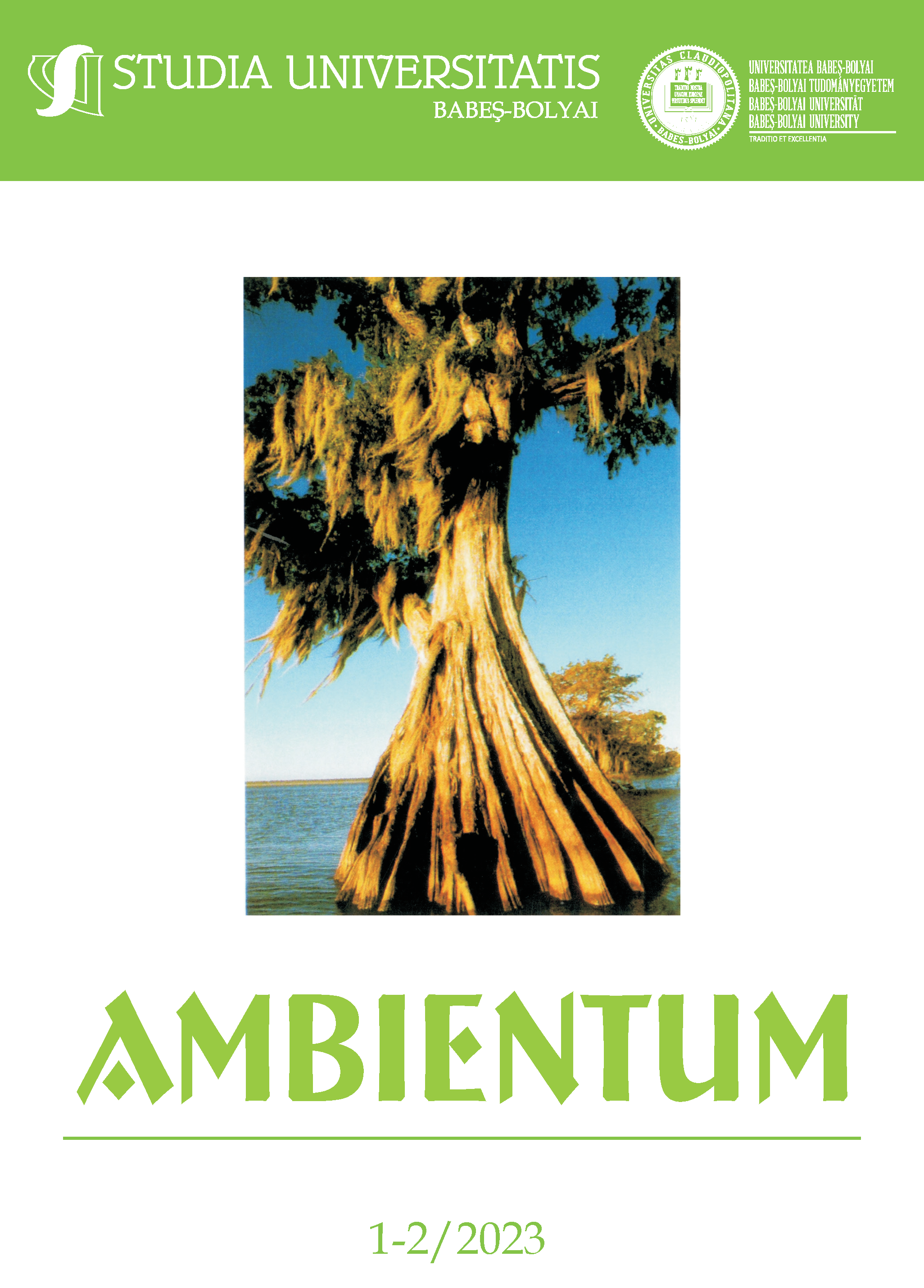MEDICAL WASTE MANAGEMENT BEFORE AND DURING THE COVID-19 PANDEMIC IN ROMANIAN HOSPITALS
DOI:
https://doi.org/10.24193/subbambientum.2023.06Keywords:
pandemic, SARS-CoV 2 (COVID-19), hazardous waste, protective equipment, medical waste managementAbstract
The proper management of medical waste is very important, throughout its life cycle, from correct collection to final recovery or disposal. The hazardous potential of this waste needs to be known by all those who handle it to protect their health, the health of the general public, and the environment. Studying them with a view to their correct management also aims to reduce the potential risks that may arise from their improper handling. The objective of the paper was to present the influence that the COVID-19 pandemic has had through the increased amounts of waste generated by health facilities to limit the spread of the virus and to treat patients infected with SARS-CoV-2. The work of the health units mainly focused on measures to limit the spread of the virus through the use of personal protective equipment, testing of the population, treatment of patients infected with SARS-CoV 2 and other patients who needed other types of medical services. To highlight how the pandemic influenced the amount of medical waste produced, three health facilities of various types were analyzed: an Infectious Diseases Hospital, a Municipal Hospital, and a hospital for a small-medium city. Data from the months when the pandemic waves started were used and compared with similar months in previous years. Hazardous medical waste disposal costs were estimated and graphs were plotted to show the unprecedented increase in the amount of medical waste generated during the SARS-CoV 2 - Covid-19 pandemic.
References
Bhagawati G., Nandwani S., Singhal S., 2015, Awareness and practices regarding bio-medical waste management among health care workers in a tertiary care hospital in Delhi. Indian Journal of Medical Microbiology, 33 (4), pp. 580-582, ISSN 0255-0857. doi: 10.4103/0255-0857.167323
Çalıs S., Arkan B., 2014, The Views of the Nursing Students about the Medical Wastes and their Effects on the Environmental and Human Health. Procedia - Social and Behavioral Sciences, 116, pp. 1472-1476, ISSN 1877-0428. https://doi.org/10.1016/j.sbspro.2014.01.419
Curea O., Bratu A.M., Constantin M., Teodorescu S.E., 2021, Waste resulting from medical activity - legal requirements and good practices, Bucharest, ISBN 978-973-0-35381-5.
Dascalu S., 2020, The Successes and Failures of the initial COVID-19 Pandemic Response in Romania. Frontiers in Public Health, 8, doi: 10.3389/fpubh.2020.00344
Dehal A., Vaidya A.N., Kumar, A.R., 2022, Biomedical waste generation and management during COVID-19 pandemic in India: challenges and possible management strategies. Environmental Science Pollution Research, 29, 14830. https://doi.org/10.1007/s11356-021-16736-8.
Dehghani M.H., Ahrami H.D., Nabizadeh R., Heidarinejad Z., Zarei A., 2019, Medical waste generation and management in medical clinics in South of Iran. MethodsX, 6, pp. 727-733, ISSN 2215-0161. https://doi.org/10.1016/j.mex.2019.03.029
European Waste Catalogue (EWC), List of Waste (LoW), (2015).
Government Decision No. 1.061/2008 on the transport of hazardous and non-hazardous waste on the territory of Romania.
Government Decision, GD 856/2002 on waste management records and approving the list of waste, including hazardous waste (in Romanian).
Hsu S., Banskota S., McCormick W., Capacci J., Bustamante C., Moretti K., Wiegn D., Martin K.D., 2021, Utilization of a waste audit at a community hospital emergency department to quantify waste production and estimate environmental impact. The Journal of Climate Changeand Health, 4, 100041, ISSN 2667-2782. https://doi.org/10.1016/j.joclim.2021.100041
Ilyas S., Srivastava R.R., Kim H., 2020, Disinfection technology and strategies for COVID-19 hospital and bio-medical waste management. Science of The Total Environment, 749, 141652, ISSN 0048-9697. doi:10.1016/j.scitotenv.2020.141652.
ISO 14001 standard for an environmental management system.
ISO 9001 standard for a quality management system.
Le A.B., Hoboy S., Germain A., Miller H., Thompson R., Herstein J.J., Jelden K.C., Beam E.L., Gibbs S.G., Lowe J.J., 2018, A pilot survey of the U.S. medical waste industry to determine training needs for safely handling highly infectious waste. American Journal of Infection Control, 46 (2), pp. 133-138, ISSN 0196-6553. doi: 10.1016/j.ajic.2017.08.017
Mihai Fl. C., 2020, Assessment of COVID-19 Waste Flows During the Emergency State in Romania and Related Public Health and Environmental Concerns, Int. J. Environ. Res. Public Health, 17, 5439; doi:10.3390/ijerph17155439
Open geospatial data for responding to the COVID-19 challenge (Coronavirus COVID-19 Romania), https://covid19.geo-spatial.org.
OHSAS 18001, Occupational Health and Safety Assessment Series.
Order 756/2004, approving the technical regulation on waste incineration) and the flue gases are purified before reaching the atmosphere,
Order of the Minister of Health No 219/2002 “Methodology for Data Collection for the National Database”.
Order of the Minister of Health No. 1226/2012, which approved the technical norms on the management of waste from medical activities and the methodology of data collection for the national database on waste resulting from medical activities.
Padmanabhan K.K., Barik D., 2019, Chapter 8 – Health Hazards of Medical Waste and its Disposal, In Woodhead Publishing Series in Energy, Energy from Toxic Organic Waste for Heat and Power Generation. Woodhead Publishing, https://doi.org/10.1016/B978-0-08-102528-4.00008-0.
Peng J., Wu X., Wang R., Li C., Zhang Q., Wei D., 2020, Medical waste management practice during the 2019-2020 novel coronavirus pandemic: Experience in a general hospital. American Journal of Infection Control, 48 (8), pp. 918-921, ISSN 0196-6553. https://doi.org/10.1016/j.ajic.2020.05.035
Silva A.L.P., Prata J.C., Walker T.R., Duarte A.C., Ouyang W., Barcelò D., Santos T.R., 2021, Increased plastic pollution due to COVID-19 pandemic: Challenges and recommendations. Chemical Engineering Journal, 405, 126683, ISSN 1385-8947. https://doi.org/10.1016/j.cej.2020.126683.
Singh N., Tang Y., Zhang Z., Zheng C., 2020, COVID-19 waste management: Effective and successful measures in Wuhan, China. Resources, Conservation and Recycling, 163, 105071, ISSN 0921-3449. doi:10.1016/j.resconrec.2020.105071.
Thind P.S., Sareen A., Singh D.D., Singh S., John S., 2021, Compromising situation of India’s bio-medical waste incineration units during pandemic outbreak of COVID-19: Associated environmental-health impacts and mitigation measures, Environmental Pollution, 276, 116621, ISSN 0269-7491. doi:10.1016/j.envpol.2021.116621.
Downloads
Published
How to Cite
Issue
Section
License
Copyright (c) 2023 Studia Universitatis Babeș-Bolyai Ambientum

This work is licensed under a Creative Commons Attribution-NonCommercial-NoDerivatives 4.0 International License.



